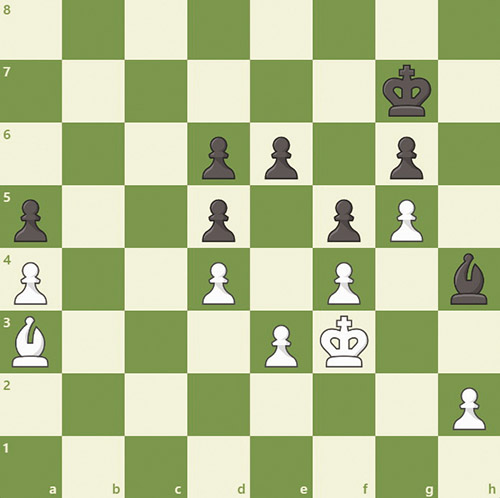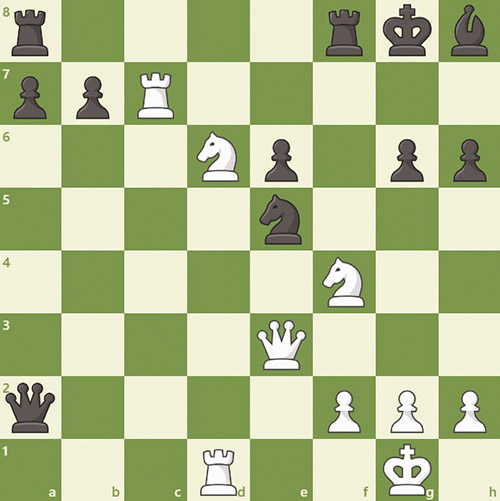
In chess, prophylaxis is a restricting move or plan that aims to prevent one’s opponent from making an action or executing an idea. This is a theme that permeates much of positional play throughout all stages of the game of chess. It is well demonstrated by the Najdorf variation of the Sicilian defense as seen in Figure 1. In this position, the move for black in Najdorf is pawn to a6, a move solely for prophylactic purposes by taking control over the b5 square. This then prevents a white bishop or knight from landing on the b5 square as often happens in other Sicilian variations. It also prepares to play pawn to b5, a key idea in the Sicilian to gain space, open up the b7 square for the bishop and launch an attack against white’s queenside.

Figure 2 is a position from a game between World Champion Anatoly Karpov with white and Grandmaster Artur Yusupov with black from the 1983 50th USSR Championship. The pawn on b5 is uncapturable due to Bxc2 followed by Nxd4 and black is threatening the positionally strong knight transfer to a5 and then c4 where is well defended and covers important squares in the white position. Therefore, Karpov began with prophylactic 1. Bd3, attacking the b5 pawn, so that after 1… Bxd3 2. Qxd3, black cannot play Na5 without hanging the b5 pawn. 2… Rfb8 3. Rfb1 b4 and white applies severe pressure along the b file against black’s b pawn, forcing b4 so that Na5-c4 hangs the b pawn. 4. h3 h6 5. Rc1 and Karpov activates his rook along the semi-open c file and opens up the b1 square so that Na5 and be met with Qb1 and black has to move the knight back to c6 to guard the pawn. 5… Rb6 6. Qb1 Rab8 and white plays the advanced idea of 7. Rc5, so that after 7… Nd8 with the threat of Nb7, Karpov pulls the rook back with 8. Rcc2 followed by 8… Nc6. With this maneuver, Karpov transferred his rook to the second rank without losing any time, allowing him to then play 9. Qc1 to put more pressure on the c file. 9… Rb8b7 10. Rc5, preventing the knight from going to a5 without the threat of Na5-b7. 10… Ne7 11. Kh2 Nf5, a mistake that allows white to win the c7 pawn by force with 12. Rb2c2 so that after 12… Rg6, white is winning after 13. Rxc7. Karpov went on to win the game 12 moves later.

The position from Figure 3 is modeled from a game between SuperGrandmasters Anish Giri with white and Jan-Krzysztof Duda with black. Material is equal and both sides have a dark squared bishop, however, black’s bishop is on the side of the board on the h4 square and can only enter the game and help defend the black pawns through the e1 square. Therefore, the only winning move for white is to refrain from capturing the d6 pawn and instead play king to e2, covering the e1 square. This prevents black from bringing the bishop into the game and is rendered helpless as the white bishop will then capture the pawns on d6 and a5, winning the game.

Figure 4 is from a game between Grandmasters Jure Skoberne with white and Isan Reynaldo Ortiz Suarez with black from the 2012 Chess Olympiad. In the position displayed in Figure 4, black is up 2 pawns but with a weak and open king. Black also has the semi-open f file putting pressure on the f2 pawn and threatens queen to a4, forking the d1 rook and f4 knight; if white protects both attacks with rook to d4, queen to a1 forks the king and the d4 rook because after the king moves (assuming a luft like h3 has been made before Qa4), black can then capture the rook on d4! After the white queen takes back, black has a winning knight sacrifice: knight to f3, and after the pawn captures the knight, the h8 bishop takes the white queen back and black has won a rook for a knight. Therefore, the only move that gives white an advantage is the prophylactic idea rook to f1, moving the rook out of the way of Queen to a4. The rook on f1 also defends the f2 pawn, preparing the sacrifice knight takes g6, and after the black knight on e5 captures back, white can play queen takes h6 and mate is unstoppable. If the rook had not been placed on f1 in that position, black would then have queen take f2 with a forced checkmate, demonstrating the strength of the seemingly quiet move.
Ethan Feder is a junior at Yeshivat Frisch, a chess enthusiast and player. The goal of his column is to teach and discuss chess concepts through example positions, high-level games and relevant puzzles, along with explanations. Feel free to contact him with any questions, suggestions or comments at ethan.feder@gmail.com.











